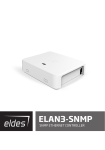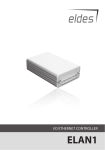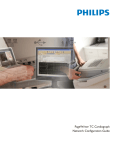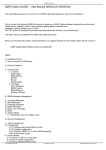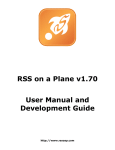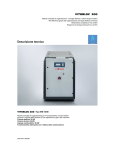Download USER MANUAL
Transcript
SMaSh – Guide for SPM interface USER MANUAL English Version 1.1 1 Interactive Toys Srl (www.itoys.it) KDEV (www.kdev.it) Index of contents 1. Introduction 3 2. System configuration 5 1.1 Purposes and target 3 2.1 Home 6 2.2 Lists 6 2.3 Setup 8 3. Using the functionalities 11 3.1 New SMS 11 3.2 Inbox 12 3.4 SMS File 14 3.3 Outbox 13 2 Interactive Toys Srl (www.itoys.it) KDEV (www.kdev.it) 1. Introduction SPM (Short Programmable Messenger) is the new interface for the SmaSh for the management of advanced messaging services locally, through a web interface very powerful and easy to use. It has been developed by Interactive Toys Srl (official site: www.itoys.it) in collaboration with KDEV (official site: www.kdev.it), a company with many years of experience in embedded systems and messaging solutions. 1.1 Purposes and target The SPM is designed for companies that need to contact by SMS (Short Message Service) a wide group of users (like customers, suppliers, employees and so on) in a fast, simple, reliable and flexible way. You can use this device to massively send messages containing informations of various nature, or to collect them with the internal SIM card. Furthermore, SPM is totally integrated with messaging services by KDEV (more informations on: www.smskdev.it). The difference between direct access via web and using this device is that in this second way you can work locally, memorizing contents and highly personalizing your communications (with less Internet traffic). Obviously, sensitive data like phonebooks and messages will be safely confined on your SPM. Being completely multi-user (more than 50 without issues) this machine is suited either for small companies, with a limited number of employees working on this sector, and for big enterprises with a quantity of offices, maybe delocalized. We recommend this device to every company that needs massive general3 Interactive Toys Srl (www.itoys.it) KDEV (www.kdev.it) purpose SMS communications (incoming and/or outgoing) like for example: Promotions through massive sendings of SMS to easily selected groups of customers; Realtime info services with informations sent by SMS; Notices dispatching to mobile employees (like sales agents, couriers, maintainers, and so on), and/or collection of urgent informations from them; Management of inter-company functions on mobile channels via SMS. 4 Interactive Toys Srl (www.itoys.it) KDEV (www.kdev.it) 2. System configuration SPM's configuration is made through the web interface, reachable at the address http://192.168.0.98:9090 with following credentials: • Username: admin • Password: admin Figure1: The Login page After you login, you will be able to access a number of graphical tabs, listed on the top bar. The ones you need to setup your device are explained in detail in the subsequent paragraphs, the others in the next chapter. With this interface, you also have the classical one for the SmaSh OS, reachable at the same address but on port 80. 5 Interactive Toys Srl (www.itoys.it) KDEV (www.kdev.it) Remember that we recommend the use of Mozilla Firefox as web browser 2.1 Home Figure2: The Home page This is the first page shown after the user logins. Here you have a welcome message, and some current status information like: • GSM signal (how good the SMS reception of the device is); • Modem demon (a diagnostic information about the demon that handles the on-board GSM modem); • SMS gateway (the actual situation of the SMS gateway engine). Moreover, at the bottom of this page, you have (as in every other page) some information about the current logged user, like his name and the credits available. 2.2 Lists 6 Interactive Toys Srl (www.itoys.it) KDEV (www.kdev.it) Figure3: The Lists page This is the internal phonebook of the system. SPM can manage a specific list for every user defined, to easily share the device among multiple agents without interferences between them. Here are available all the classic features for these lists. So, you can visualize, filter, add, modify, delete and search the phone numbers. An additional function is to import your contacts from a CSV file. This is an easy to use feature that will allow you to populate your list with phone numbers coming from other softwares, or maybe from another user of the device. On the other hand, you can obviously export in CSV format your own list for the same reasons as above. Under the list is then present a direct link to the sending function, operating on phone numbers selected. This takes you to the classical sending page (see next chapter for more info), directly importing the numbers to the “To:” field. Note that application allows you to import more times the same phone numbers, maybe associating them to different names or groups according to your needs. However, to keep trace of these duplicates, you have a button that shows them highlighting related rows. 7 Interactive Toys Srl (www.itoys.it) KDEV (www.kdev.it) 2.3 Setup From here it is possible to define your system parameters. Obviously, this section is modifiable only when the user currently logged in is the Admin of the system. This is divided into three subsections, with different aims and uses. Figure4: The Setup page 2.3.1 System setup Here you have all the parameters needed by you SPM to work with your IT architecture. First of all, you can configure some network setting like: IP (IP address of this SPM); Subnet (the subnet mask of the network which device is linked to); Gateway (the gateway of the network); Broadcast (the broadcast IP address of the network); DNS (IP address of your DNS server). Then, you have a field where you can indicate the fully-qualified domain name, or the IP address, of your NTP server. This is needed because interacting with a 8 Interactive Toys Srl (www.itoys.it) KDEV (www.kdev.it) messaging system needs a reliable synchronization about the current timestamps. Lastly, you have a subsection in which you define some information regarding your SMTP server. These will be used by SPM to alert you when you are short on credits. More in detail, you have: Hostname/IP (the FQDN, or the IP address, of the SMTP server); Username (the username to login on server); Password (the password of this user); Auth type (authorization method used by the SMTP server, see below); Port (the port number of the SMTP service on server). Note that this device supports all the typical SMTP authentication methods. In the related field you can write (pay attention to the syntax): “NO” to disable any kind of authentication; “-auth-cram-md5” to enable the CRAM-MD5 authentication; “-auth-plain” to enable the plain text authentication; “-auth-login” to enable the login mechanism. 2.3.2 SPM Admin account In the first part, it is possible to modify this account, setting a new password that will definitively substitute the old one, or a new mail address associated (used by users to contact the Admin). In the second part, we have the credentials to use KDEV SMS. These are needed to do message sendings using KDEV SMS services instead of the typical mobile operator one. Fields here required are: ID (is the account name given by KDEV); Password (is the associated password); Default sender (the default sender that appears in sent SMS); Email address (the address where Admin gets the alerts and so on). The “Credit” field will be auto-filled with informations from our servers, to keep always updated its value. 9 Interactive Toys Srl (www.itoys.it) KDEV (www.kdev.it) In order to get more informations about this service, please visit the website: www.smskdev.it 2.3.3 SPM Users This is the third and last section. Here you have a list of the users currently associated to the device, and a simple form to modify and delete them, or to add someone new. Practically it works like the phonebook, showing the same functions, but obviously its target are the users of the SPM instead of the future SMS recipients. A particularity is the “Keyword” field, that contains a string (unmodifiable by associated user) used by the application to filter incoming messages (see 3.2 for more info). Also note the “Credit” field. This is a utility to make easier sharing the device among multiple agents. In fact, associating only a part of the credit available on this SPM to each user, you can handle it better (example, ensuring that none will run out of credit independently from other users' sendings). 10 Interactive Toys Srl (www.itoys.it) KDEV (www.kdev.it) 3. Using the functionalities 3.1 New SMS Figure5: The New SMS page Here you can write and send a new message (also to multiple recipients). You can also schedule them for delayed sendings. Let's analyze all the listed fields and comment them: 1. Sender: the string that will appear as sender of the SMS (maybe a number, or just a custom name); 2. To: the phone number/s of the recipient/s of the message. You can handwrite them singularly, or select them from the contact list (see 2.2 for more info); 3. Text: the body of the message, with a max length of 1836 characters; 4. Choose service: you can either send your messages through the SIM 11 Interactive Toys Srl (www.itoys.it) KDEV (www.kdev.it) card, as with a classic mobile phone, or forward them to our messaging services with lower costs (more informations on: www.smskdev.it). 5. Schedule: if checked, allows you to select the time when sending the messages. This option is particularly useful for advanced management of messaging solutions, such as planned sendings. 3.2 Inbox Figure6: The Inbox page This is the list of the received messages. It is common and shared among all users, however as you will soon read, SPM has safe methods to handle private queues. Here you can operate at two different levels: At a “single message” level, you are able to visualize, delete, reply, search and download (in CSV format) every message you ever received. At a “message list” level, you can do practically the same as above but on the entire list (or a selected sublist). As previously said, only if you are the Admin you can set a keyword (unmodifiable by other users) to easily and safely share the SIM card between multiple agents. Practically, this keyword will be searched in all the received 12 Interactive Toys Srl (www.itoys.it) KDEV (www.kdev.it) messages (as an high-level filter) and these will be shown only if it is found, so every user will see only messages dedicated to him (maybe containing his name in the text, or a particular code, ...). Another useful feature allows you to populate the contact list with the numbers of the senders taken from your Inbox. These will appear directly in the phonebook, marked with group “INBOX” and their number as name. Obviously, if needed you can then modify these contacts editing their name, group, and so on. 3.3 Outbox Figure7: The Outbox page Unlike the Inbox, the Outboxes are more than one, and each one is dedicated to a single user. Obviously, every agent can only access the one he owns. These are the lists of the sent messages, so you can find all the messages you wrote, with all their details. To simplify the management of large bunches of SMS, in this page you can delete single messages or selected sublists, and filter the list with some keyword. 13 Interactive Toys Srl (www.itoys.it) KDEV (www.kdev.it) 3.4 SMS File Figure8: The SMS File page Here you have a tool that significantly simplifies the sending of multiple messages, maybe heterogeneous, through the use of a previously generated CSV (Comma-Separated Values) file. The format you need to follow is: sender1,destination1,text1 sender2,destination2,text2 etc. Practically, you only need to generate this CSV file, then you import it, choose the sending service and it is done. It is also possible to basically post-product your list with the List Editor Tools, substituting some word with another, or adding the international prefix in front of the phone numbers (it is needed for correct sendings). 14 Interactive Toys Srl (www.itoys.it) KDEV (www.kdev.it)















